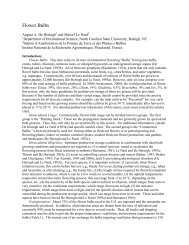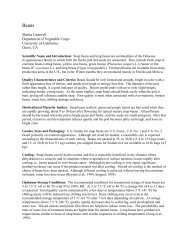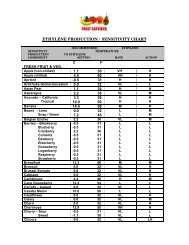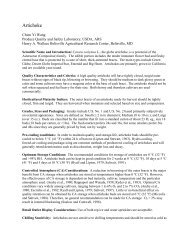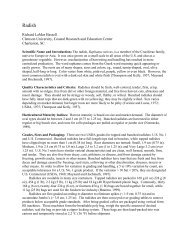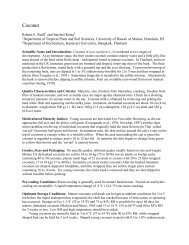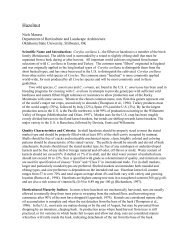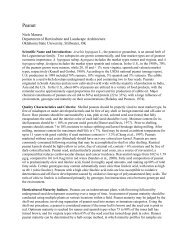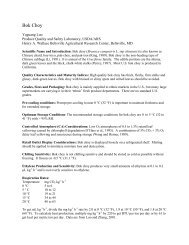Southern Pea
Southern Pea
Southern Pea
You also want an ePaper? Increase the reach of your titles
YUMPU automatically turns print PDFs into web optimized ePapers that Google loves.
<strong>Southern</strong> <strong>Pea</strong><br />
Penelope Perkins-Veazie 1 and Blair Buckley 2<br />
1 South Central Agricultural Laboratory, USDA, ARS, Lane, OK<br />
2 Louisiana State University Research Station, Calhoun, LA<br />
Scientific Name and Introduction: <strong>Southern</strong> pea, or cowpea, [Vigna unguiculata (L.) Walp.] is a native<br />
of Africa and is adapted to hot dry climates. The southern pea is not actually a pea, and thus differs<br />
considerably from the green or English pea (Pisum sativum) (Peirce, 1987). Prized in the southern U.S.,<br />
southern peas are rich in folic acid, fiber, and calcium. <strong>Pea</strong>s are distinguished by pod color, pea color and<br />
pattern, and hilum color. Five groups of cultivars are recognized on the basis of seed and pod coloration,<br />
and seed packing in pod. They include Blackeye (California Blackeye No. 5), Cream (‘Elite’), Purple<br />
Hull (‘Pinkeye Purple Hull’), Crowder (‘Mississippi Silver’), and miscellaneous other colored, noncrowder<br />
peas (‘Dixielee’). ‘Bettersnap’ was developed specifically for edible pods (Fery and Dukes,<br />
1995).<br />
Quality Characteristics and Criteria: Some cultivars have edible pods (similar to green beans) and<br />
should be harvested when the pods are 10 to 16 cm (4 to 6 in) long, flexible, and dark green. The shelled<br />
peas should be a mature size, smooth skinned, and exhibit characteristic color.<br />
Horticultural Maturity Indices: Fresh market southern peas are harvested when the pods are at the<br />
mature-green stage (peas are fully developed and the majority of the pods have undergone a color<br />
change). It is acceptable to have some pods that have not undergone a complete color change (green with<br />
some purpling in the case of purple hulls) provided the peas are mature size. Shelled peas preferably<br />
should be light green in color. <strong>Pea</strong> color is affected both by maturity and cultivar. Tan or white pea color<br />
is perceived to be too mature (except for cream types). Blackeye cultivars are the most difficult to<br />
determine when to harvest for fresh use because the color of the black hilum does not fully develop until<br />
at peak maturity. The color will be purple to chocolate-brown if harvested early. If southern peas are to<br />
be harvested for edible pod use, they must be selected when quite young and tender, ie., no more than 1/2<br />
of the expected diameter of mature green pods, unless using a cultivar specifically developed for edible<br />
pod use.<br />
Grades, Sizes and Packaging: USDA grades of southern peas are U.S. No. 1 (95% of pods must be at<br />
least 12.5 cm (5 in) long, and U.S. Commercial (no minimum length requirement). Shelled peas are<br />
marketed in 4.5 to 5.4 kg (10 to 12 lb) plastic bags (considered the equivalent amount of a shelled bushel)<br />
or in 0.45 kg (1 lb) bags. Some large operations package peas in vacuum-packed 0.45 and 4.5 kg (1 and<br />
10 lb) bags. No grades exist for southern peas used as snap beans. Fresh southern peas may also be sold<br />
in the hull by the bushel. A USDA bushel is 11.4 kg (25 lbs); however, at the local market level the<br />
bushel weight varies widely from region to region or from 7.3 to 13.6 kg (16 to 30 lbs). Pods for shelling<br />
are packed primarily in meshed bags (cabbage sacks) or wooden bushel baskets (increasingly less<br />
common).<br />
Pre-cooling Conditions: In both shelled and unshelled states, peas are very prone to decay if held at<br />
room temperature. Unshelled peas are best cooled using a forced-air system. Contact with water greatly<br />
accelerates their deterioration. Shelled peas should be blown free of foreign material and then hydrocooled<br />
in 100 ppm chlorine to remove heat quickly, preserve green color, and slow microbial growth.<br />
<strong>Pea</strong>s to be trucked for processing are shelled into field bins where temperatures may reach 38 °C (100 °F)<br />
(Hardenburg et al., 1986). <strong>Pea</strong>s start to yellow and decay after a few h at 25 °C (77 °F). Flavor<br />
deterioration and off-flavor in shelled peas may be a problem if they are held for as much as 7 h at 30 °C
(86 °F) before processing.<br />
Optimum Storage Conditions: <strong>Southern</strong> peas in the pod can be held for 6 to 8 days at 4 to 5 °C (39 to<br />
41 °F) with 95% RH. Without refrigeration, they remain edible only about 2 days and show extensive<br />
decay in 4 to 6 days. Shelled peas should be held for no more than 24 to 48 h at 4 to 5 °C (39 to 41 °F)<br />
(Jenkins, 1954).<br />
Controlled Atmosphere (CA) Considerations: Unknown.<br />
Retail Outlet Display Conditions: Keep under high RH, refrigerate to slow decay and color loss.<br />
Chilling Sensitivity: Unknown, probably sensitive when held at 5 °C (41 °F) or below.<br />
Ethylene Production and Sensitivity: Unknown, probably sensitive to ethylene with effects<br />
characterized by yellowing of pods.<br />
Respiration Rates:<br />
Temperature Whole pods Shelled peas<br />
(mg CO 2 kg -1 h -1 )<br />
2 °C 12.5 to 36.3 25.5 to 33.3<br />
5 °C 15.9 to 33.4 -<br />
20 °C 144.8 to 150.9 89.8 to 161.2<br />
To get mL kg -1 h -1 , divide the mg kg -1 h -1 rate by 2.0 at 0 °C (32 °F), 1.9 at 10 °C (50 °F), and 1.8 at 20 °C<br />
(68 °F). To calculate heat production, multiply mg kg -1 h -1 by 220 to get BTU per ton per day or by 61 to<br />
get kcal per metric ton per day. Data are from P. Perkins-Veazie (unpublished). Data are from pods 15 to<br />
23 cm long, of cultivars Excel, BetterSnap, Early Scarlet, Pinkeye Purple Hull BVR. Higher respiration<br />
values are for less mature (more green) peas and pods.<br />
Physiological Disorders: Brown spots, cracking and seed-coat splitting are problems with pods and<br />
peas.<br />
Postharvest Pathology: Very little research has been done on postharvest pathogens of southern pea.<br />
Botrytis cinerea (Gray Mold) can quickly develop on pods and shelled peas (Roland E. Roberts, Texas<br />
A&M, personal communication).<br />
Quarantine Issues: None known.<br />
Suitability as Fresh-cut Product: Snap pea or yard-long cowpea cultivars, ex., Bettersnap, can be used<br />
as a fresh-cut product. These types must be harvested at the immature pod stage.<br />
Special Considerations: Failure to pre-cool shelled peas prior to packaging results in condensation in<br />
the bags and rapid souring and spoiling of the peas. Insect damage can create major postharvest grading<br />
problems due to feeding damage and misshaped peas caused by stinkbugs, and punctures and larvae<br />
inside of peas as a result of cowpea cucurlio.<br />
References:<br />
Fery, R.L. and P.D. Dukes. 1995. ‘Bettersnap’ southernpea. HortScience 30:1318-1319.<br />
Hardenburg, R.E., A.E. Watada, and C.Y. Wang. 1986. The Commercial Storage of Fruits, Vegetables,<br />
and Florist and Nursery Stocks. USDA Agric. Hdbk No. 66, Washington, D.C.
Jenkins, W.F. 1954. Postharvest changes in refrigerated and non-refrigerated southern peas. Proc. Amer.<br />
Soc. Hort. Sci. 64:327-330.<br />
Peirce, L.C. 1987. Legumes-southern pea. In: Vegetables: characteristics, production, and marketing. J.<br />
Wiley and Sons, NY, pp. 345-347.



